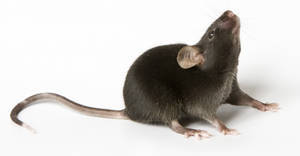Virtually everyone who has had a limb amputated reports still feeling a "phantom" limb, and most people occasionally feel a spontaneous burning, stabbing or electric shock-like pain coming from that limb. Using a mouse model of phantom pain—the "Neuroma model"—and integrating fine mapping, bioinformatics, gene expression and comparative genomics strategies, a research team led by Dr. Ariel Darvasi of the Hebrew University of Jerusalem has found that the calcium channel, voltage-dependent, gamma subunit 2 (Cacng2) gene plays a key role in pain sensation following nerve injury (Nissenbaum et al. 2010).
The Neuroma pain model
The Neuroma model simulates the phantom pain some people experience following amputation or mastectomy. Specifically, a mouse's hind paw is completely denervated, and the phantom pain is monitored by scoring "autotomy" – scratching and biting the numb paw. Autotomy behavior varies considerably among individuals and inbred mouse strains.
A pain QTL is mapped to mouse chromosome 15
Using the Neuroma model, the Darvasi team had previously identified and mapped an autotomy quantitative trait locus (QTL), Pain1, to an approximately 25-cM interval on mouse chromosome (Chr) 15. To identify the gene underlying Pain1, the team began by executing two independent fine-mapping strategies. The first was a recombinant progeny test (RPT) involving JAX® Mice strain C58/J (000669) and strain C3H/HeN. The second was a recombinant inbred segregation test (RIST) involving JAX® Mice recombinant inbred strains BXA7/PgnJ (001696) and BXA8/PgnJ (001697) and the two progenitor strains A/J (000646) and C57BL/6J (000664). Combining the RPT and RIST results narrowed Pain1 to a 4.2-Mb interval (between 75.27 and 79.5 Mb) containing 155 catalogued genes on Chr 15.
Closing in on the pain QTL gene
Seven inbred strains – 129P3/J (000690), AKR/J (000648), A/J (000646), BALB/cJ (000651), C57BL/6J (000664), C3H/HeN, and DBA/2J (000671) – have an established Neuroma model pain phenotype. The Mouse Phenome Database contains single nucleotide polymorphism (SNP) data for these or closely related strains – 129S1/SvImJ (002448) instead of 129P3/J and C3H/HeJ (000659) instead of C3H/HeN. Three of the seven strains (A/J, C3H/HeN, BALB/cJ) exhibit high autotomy, and four (129/J, AKR/J, C57BL/6J, DBA/2J) exhibit low autotomy. By analyzing which SNPs in the 4.2 Mb Pain1 region co-segregate with either low or high autotomy, determining which of these SNP sequences alters protein sequence, and searching PubMed for genes that play a role in pain, Davasi and his colleagues narrowed the Pain1 QTL to a nine-gene section in the middle of the 4.2 Mb Pain1 QTL.
Gene expression analyses identify Cacng2
Darvasi and his colleagues next compared the gene expression patterns in a major paw ganglion among low autotomy strains AKR/J, CBA/J, C57BL/6J, and C58/J and high autotomy strain C3H/HeJ. Whereas the paws in some groups had been completely denervated, the paws in others had undergone a sham operation. Nerve injury had a significant effect on the expression level of only one gene, Cacng2, down-regulating its expression significantly in the high autotomy C3H/HeJ strain. Cacng2 met all four of the Darvasi team's criteria: 1) it co-segregates perfectly with the autotomy phenotype; 2) it functions in pain sensation; 3) its expression is significantly altered following nerve injury; and 4) its expression level differs between high and low autotomy strains.
Cacng2-mutant mouse exhibits autotomy

"Stargazer" JAX® Mice strain B6C3Fe a/a-Cacng2stg/J (001756), a Cacng2 hypomorph, is commonly used in epilepsy research. To substantiate Cacng2's role in pain susceptibility in mice, Darvasi and colleagues compared the degree of autotomy in Cacng2 hypomorphic mutant stargazer (Cacng2stg/stg), Cacng2 heterozygous (Cacng2stg/+) mice, and wild-type controls. The results from several experimental strategies clearly demonstrated that the Cacng2stg/stg genotype is associated with the most autotomy.
Human CACNG2 gene is associated with phantom pain
To determine if the homologous human gene, CACNG2, is associated with phantom pain, Darvasi's team compared the genotypes of 215 breast cancer patients who had, and 334 who did not have, chronic pain following a mastectomy. They found a statistically significant association between women who were homozygous for three SNPs in CACNG2 and those who experienced chronic pain.
The integrated strategies used by Darvasi and his colleagues strongly implicate CACNG2's role in pain processing following nerve injury, increase our understanding of pain physiology, and may lead to new therapies for treating pain.
Reference
Nissenbaum J, Devor M, Seltzer Z, Gebauer M, Michaelis M, Tal M, Dorfman R, Abitbul-Yarkoni M, Lu Y, Elahipanah T, delCanho S, Minert A, Fried K, Persson A, Shpigler H, Shabo E, Yakir B, Pisante A, Darvasi A. 2010. Susceptibility to chronic pain following nerve injury is genetically affected by CACNG2. Genome Research, 2010; DOI: 10.1101/gr.104976.110.